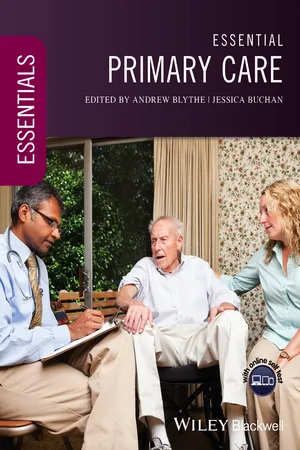
- English
- ePUB (mobile friendly)
- Available on iOS & Android
Essential Primary Care
About This Book
Essential Primary Care aims to provide undergraduate students with a comprehensive overview of the clinical problems encountered in primary care. It covers the structure of primary care in the UK, disease prevention and the management of common and important clinical presentations from infancy to old age. Case studies are used in every chapter to illustrate key learning points.The book provides practical advice on how to consult with patients, make sense of their symptoms, explain things to them, and manage their problems. Essential Primary Care:
•Is structured in five sections:
- The building blocks of primary care: its structure and connection with secondary care, the consultation, the process of making a diagnosis, prescribing, and ethical issues
- Health promotion
- Common and important presenting problems in roughly chronological order
- Cancer
- Death and palliative care
•Gives advice on how to phrase questions when consulting with patients and how to present information to patients
•Provides advice on how management extends to prescribing - often missing from current textbooks
•Contains case studies within each chapter which reflect the variety of primary care and provide top tips and advice for consulting with patients
• Supported by a companion website at www.wileyessential.com/primarycare featuring MCQs, EMQs, cases and OSCE checklists
Frequently asked questions
Information
Part 1
The key features of primary care
CHAPTER 1
The structure and organisation of primary care
Key topics
- What is primary care?
- Organisation of primary care in the UK
- What can be done in primary care?
Learning objectives
- Understand the benefits of a health service that is based on primary care.
- Understand the scope and limitations of primary care in the UK.
- Appreciate how primary care is evolving in the UK.
What is primary care?
The importance of primary care
Knowing t...
Table of contents
- Cover
- Title Page
- Table of Contents
- Contributors
- Foreword
- Preface
- How to use your textbook
- About the companion website
- Part 1: The key features of primary care
- Part 2: Healthy living and disease prevention
- Part 3: Common presenting problems
- Childhood
- Early adulthood
- Middle and old age
- Part 4: Cancer
- Part 5: Palliative care and death
- Index
- End User License Agreement